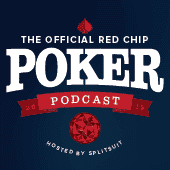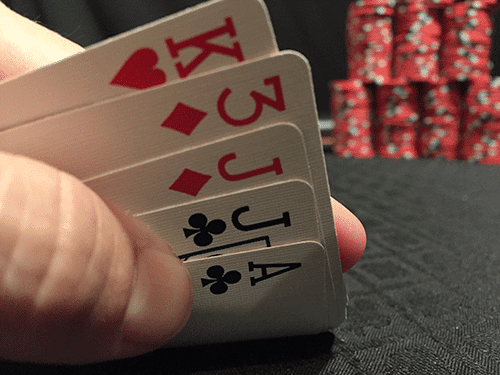James “SplitSuit” Sweeney is very excited to host this episode of the Red Chip Poker podcast on his favorite poker variant, Big O.
Don’t worry if you’ve never played a hand of Big O or aren’t sure what it even is. Sweeney walks listeners from the basics all the way to advanced strategy. In fact, you should take special comfort in knowing that this knowledge is not widespread. That means you can listen to this podcast, show up wherever Big O is spread, and already have a nice edge over players who lack any sort of training beyond playing the game.
Big O is not the super-niche game it used to be. It even made an appearance in some of the WSOP events this year. And Sweeney played in the Big O games at the Rio during the series this year, where it was running as a cash game around the clock.

How to Play Big O
We previously covered all the basics of how to play Big O, so if you’re totally new to the game, we encourage you to read our ‘How to Play Big O’ guide before proceeding with the rest of this podcast.
The super-short version is that Big O is essentially the same exact game as Omaha Eight-or-Better with one exception: you get five-card hand instead of a four-card hand.
The first thing to realize about getting this fifth card is that many players don’t know what do with it. They assume there will be less skill involved with more cards to connect to the board. Sweeney says this offers a huge profit potential due to them playing more crappy hands than they ought, under the false assumption that the fifth card gives them a better chance of winning than it actually does.
Because this is a pot-limit game, lots of players will be playing big pots and calling down with second-best, so you have the opportunity to hit nuts and get paid off.
Differences Between Hold ‘Em and Big O
In terms of skills you can develop at Big O that translate into No Limit Hold ‘Em and other games, pot control and pot geometry are going to be big areas where you want to sharpen your skills.

That said, it’s important to note the big differences between the game we’re all familiar with, and the more exotic Big O. For example, aces are obviously the monster of all monsters in hold ’em, but in Big O they are massively overvalued by many players.
AA2QJ vs. AAK67 is a massive difference. You’re not going to make a nut low with the second hand. And you have to remember, scooping is your major focus in O8, and Big O is no exception. So having a hand that can scoop is super-important. In that sense, A23KK blows AA79Q out of the water.
This fact does not occur to all players, and you will find a lot of folks who are playing hands with premium pairs and broadway cards but a raggy low draw. With the right board, you can punish these players.
Be very disciplined when it comes to the hands that you’re playing, and you’ll already have an edge.
Three Elements of Big O
Sweeney identifies three major elements of winning at Big O:
- Hand Selection
- Position
- When to Play Aggressively
Hand Selection
In addition to the tips already mentioned, one thing to keep in mind is that in this game, equities run very close together, especially preflop. There’s not a whole lot of edge in creating monster pots pre, and the pots will grow big anyway much of the time. Unless there are players who are folding to all your 3-bets, you want to be prepared to fight multiway.
You need to have your eyes glued to what other people have anytime there’s a showdown. It becomes super-important to know what kinds of hands other players are showing up with, and to what degree they’re chasing the nuts or second nuts, or playing unscoopable hands. This is going to be a huge chunk of the information you base your actions around. Particularly when you see someone 3-bet, you’re going to want to pay very close attention to the hand they’re holding when they do it.
If you see someone limp/call and they get to showdown with JT643, you need to take a mental note and can automatically rank them as a bad player. Because hand selection is the most important factor in Big O, someone who doesn’t grasp this basic fact should have a big target over their heads.
Position
Being in late position is fantastic, but that’s not an excuse for playing trashy hands. You’re going to have to go deep in big multiway pots, and you want to bring the big guns from the get-go.
Position is so important for precisely the same reason — you’re going to be facing big pot-sized bets on multiple streets from multiple opponents. Having position gives you just as much an opportunity to get out of the way of made nut hands as it does to exploit other players’ tendencies to hang in there and try to draw the miracle out — or an out that is the second nuts to your nuts.
In this way, position in Big O is not just incredibly important, but much more nuanced than in NLHE. While the value of position is amplified throughout the hand, it is also muted, particularly preflop, where equities run close together.
When to Play Aggressively
Sweeney shares his ‘secret’ to winning at Big O: lots of limping.
Because, once again, equities run close preflop, the value of raising shrinks considerably. In hold ’em, we play aggressively preflop to take advantage of big equity gaps. They simply don’t exist that often in Big O.
The other tip Sweeney has re: limping is that it’s unlikely to thin the field in most games. Raising preflop is only going to build a bigger pot with roughly the same number of players who would have seen a flop anyway, and now they are going to be fighting more aggressively for the bigger pot. You’re only giving yourself a smaller SPR and less maneuverability by turning on the aggression preflop. Of course, there are exceptions. If raises create heads-up pots, then by all means, exploit that. But in Sweeney’s experience, these types of tight Big O games are few and far between.
Limping doesn’t mean opening to a looser range for Sweeney. He is still limping with good-to-great hands.
3-Betting in Big O
Based on all this information, Sweeney is looking for opportunities to limp-reraise more than he’s looking to 3-bet preflop. Because 3-betting preflop would either telegraph the strength of his holding, or necessitate opening up to a wider range to prevent that, the limp-reraise is something he’s a bigger fan of. It’s much more likely to build the kind of bigger pot preflop that will get his hand heads-up vs. a 3-bet pot that multiple players are likely to call.
Sweeney relates a hand where he limp-reraised only to see multiple players call preflop, creating a $2500 pot in a $500-buyin game. He notes that assuming such a move will get you heads-up is an assumption that one should be sure of, because if it is a false assumption, it can get you into trouble.
Remember that limping preflop instead of 3-betting can bring worse hands along for the ride, and if they are worse hands, they are probably piloted by worse players, who may call down your strong high/low hand with a second-best hand and pay you off far more than if they shied away from a big pot on a flop they were drawing dubiously from.
More Specific Big O Tips
Beware set-over-set in Big O. It happens a lot. One tip he shares is to value sets 99+ a bit more. For example, if you try to setmine with 44 and catch the 4, it’s more likely there’s going to be a low out there, and more likely there’s a better set out there.
Focus on hands that have two-way potential and be cognizant as to how your hand will hit the board. You want high-straight hands instead of low-straights. You want nut flushes and not second-nuts. And remember, just like vanilla Omaha, Big O is a game of flushes. You can punish folks who are constantly drawing to second-best flushes with a suited ace in your hand, and also have a shot at the low.
The worst thing you can do in this game is constantly draw to second-second. Imprint that in your brain.
Another critical tip: When it comes to playing aggressively, ask yourself: “Is it more valuable to flat and play a bit more passively to bring other players with worse hands and draws along for the ride?”
For example, if you see a bet in front of you with a nut draw or made nut hand, it’s often better to call and trap them vs. raise and dissuade them from chasing that non-nut hand. Let your opponents’ second-best equity improve against your better hand and reap the rewards.
One miscellaneous piece of advice: Watch the dealer. Because Big O is a much less frequently-spread game, these tables often have a reputation of being player-run. Keeping an eye on the size of the pot and which hands are best on the high and low sides is absolutely critical with so many cards out there and the numerous chopped pots. Especially at big showdowns where there can be quartering and multiple people trying to figure out which hands are best, pay close attention, but don’t contribute to the freakout that may be happening. Keeping the table and the dealer calm is efficient, kind and keeps the game flowing smoothly.
Another comment Sweeney has is about structure. At the World Series of Poker, Sweeney picked the $1/$2 game with a mandatory $5 straddle over the $5/$5 game. For him, the $1/$2 game was far-and-away better than the $5/$5 game. Why? Because you get a lot of $1/$2 players who sit there and think it’s a $1/$2 game, but because there’s a $5 mandatory straddle, it plays essentially like a $2/$5 game.
He also suggested keeping your raises to $5 increments to keep the game flowing smoothly. The math involved in white-chip pots will slow the game down. His advice is to use white chips only for the blinds, and make all your move with red chips. Always suggest that the dealer or room do this if you notice white chips hitting the pot postflop.
